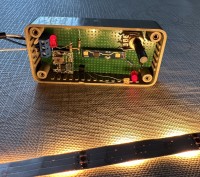Sensor light with human presence detector

Nothing as annoying as when working at your desk and your lights go out.
Everyone knows the PIR sensor lights and how they work and sometimes they have a mind on their own. With the new cheap radar human presence detectors it is possible to solve some of the issues that a PIR sensor has. Radar detector have a real presence detection even when your not moving. It's radar soo it's immune of false positive detections because of changing lights, a bee, moving hot air ....
The HLK-LD2410 is such a sensor. You can config the behavior via a standard FT232 and your PC. Once configured you have an OUT pin that goes high when a person is in it's range. In order to have it react like a sensor light, darkness has to be detected....
This is done via a LDR resistor and an TL431 (U1) is used as comparator. RP1 allows to configure darkness threshold. Once darkness has detected the HLK-LD2410 is powered on via P-channel mosfet Q1 and an MP1584 step down power module. If a person is detected the HLK-LD2410 generates a 3.3V on it's OUT pin and this switches n-channel powermosfet Q2 on and let there be light..;-)
When your light is feedback into the LDR the light would switch off and this would result in an oscillating loop. To avoid this disco lighting there is a second TL431 U2 who forces the light on when the HLK-LD2410 it's output is high.
It's a simple analog circuit with an advanced cheap sensor. Hope it will help you with the convienience of a relieable lighting.
Any sugestions on how to improve the circuit are welcome.
The HLK-LD2410 is such a sensor. You can config the behavior via a standard FT232 and your PC. Once configured you have an OUT pin that goes high when a person is in it's range. In order to have it react like a sensor light, darkness has to be detected....
This is done via a LDR resistor and an TL431 (U1) is used as comparator. RP1 allows to configure darkness threshold. Once darkness has detected the HLK-LD2410 is powered on via P-channel mosfet Q1 and an MP1584 step down power module. If a person is detected the HLK-LD2410 generates a 3.3V on it's OUT pin and this switches n-channel powermosfet Q2 on and let there be light..;-)
When your light is feedback into the LDR the light would switch off and this would result in an oscillating loop. To avoid this disco lighting there is a second TL431 U2 who forces the light on when the HLK-LD2410 it's output is high.
It's a simple analog circuit with an advanced cheap sensor. Hope it will help you with the convienience of a relieable lighting.
Any sugestions on how to improve the circuit are welcome.




Discussie (0 opmerking(en))